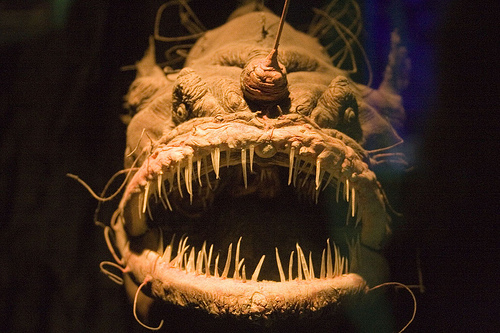
Anglerfish are the members of the order Lophiiformes These bony fish are named after their characteristic mode of predation, wherein a fleshy growth from the fish's head and acts as a lure. This action is considered analogous to angling. Some anglerfish are pelagic (live in the open water), and some are benthic (bottom-dwelling). Some live in the deep sea and others on the continental shelf (e.g. the frogfishes).
They occur worldwide. Pelagic forms are generally laterally compressed whereas the benthic forms are more often dorsoventrally compressed or depressed often with large upward pointing mouths. With 160 currently recognized species, distributed among 11 families, it is by far the most species-rich vertebrate taxon within the bathypelagic zone, containing more than twice as many families and genera and more than three times the number of species as the Cetomimoidei, the next most species-rich bathypelagic vertebrate taxon.
Predation
The fish are named for their characteristic method of predation. Anglerfish typically have three long filaments sprouting from the middle of the head. These filaments are the detached and modified three first spines of the anterior dorsal fin. In most anglerfish species, the longest filament is the first . This first spine protrudes above the fish's eyes, and terminates in an irregular growth of flesh called the esca at the tip of the spine. The spine is movable in all directions, and the esca can be wiggled so as to resemble a prey animal. This allows it to act as bait to lure other predators close enough for the anglerfish to devour them whole. The jaws are triggered in automatic reflex by contact with the tentacle. Some aphotic zone dwelling anglerfish emit light from their esca to attract prey. This bioluminescence is a result of symbiosis with bacteria. The bacteria enter the esca from the seawater through small vents. In the confines of the esca they can multiply until their density large enough that their collective glow is bright.
With most species a wide mouth extends all around the anterior circumference of the head, and both jaws are armed with bands of long pointed teeth, which are inclined inwards, and can be depressed so as to offer no impediment to an object gliding towards the stomach, but to prevent its escape from the mouth. The anglerfish is able to distend both its jaw and its stomach, since it has bones that are thin and flexible, to an enormous size, allowing it to swallow prey up to twice as large as its entire body. Some benthic or bottom-dwelling forms have arm-like pectoral fins that the fish use to walk along the ocean floor. The pectoral and ventral fins are articulated to the point to where they can perform the functions of feet, enabling the fish to move, or rather to walk, on the bottom of the sea, where it generally hides itself in the sand or amongst seaweed. All around its head and also along the body the skin bears fringed appendages resembling short fronds of seaweed, a structure which, combined with the extraordinary faculty of assimilating the colour of the body to its surroundings, camouflage the fish in areas abundant with prey.
Reproduction
Anglerfish employ an unusual mating method. This method of reproduction was derived because individuals are presumably locally rare and finding a mate is problematic. To date, permanently attached males have been found in only 5 of the 11 ceratioid families, 10 of the 35 genera, and 23 of the 160 recognized species.
When scientists first started capturing ceratioid anglerfish, they noticed that all of the specimens were females. The specimens captured were a few inches in size and almost all of them had what appeared to be parasites attached to them. It turned out that these "parasites" were the remains of male ceratioids.
At birth, male ceratioids are already equipped with extremely well developed olfactory organs that detect scents in the water. When it is mature, the male's digestive system degenerates, making him incapable of feeding independently, which necessitates his quickly finding a female anglerfish to prevent his death. The sensitive olfactory organs help the male to detect the pheromones that signal the proximity of a female anglerfish. When he finds a female, he bites into her skin, and releases an enzyme that digests the skin of his mouth and her body, fusing the pair down to the blood-vessel level. The male then atrophies into nothing more than a pair of gonads, which releases sperm in response to hormones in the female's bloodstream indicating egg release. This extreme sexual dimorphism ensures that, when the female is ready to spawn, she has a mate immediately available.
The spawn of the anglerfish of the genus Lophius consists of a thin sheet of transparent gelatinous material 2 or 3 feet wide and 25 to 30 feet long. The eggs in this sheet are in a single layer, each in its own cavity. The spawn is free in the sea. The larvae are free-swimming and have the pelvic fins elongated into filaments. Such an egg sheet is rare in fish.